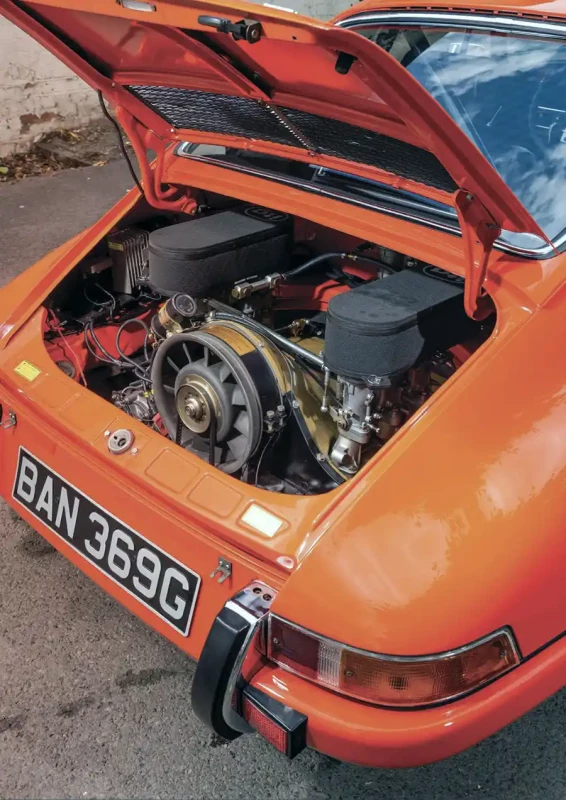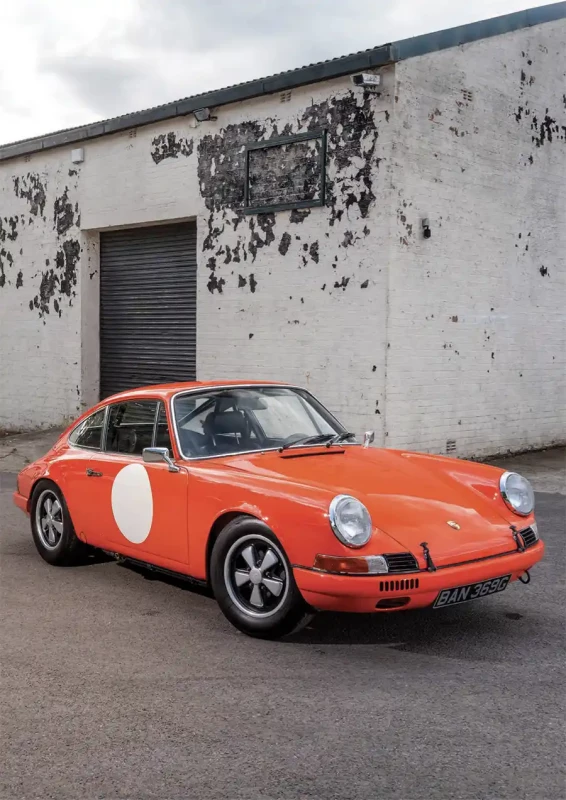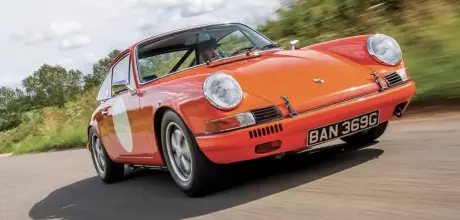Restored championship-winning Porsche 911 E
If this spectacular orange 911 E looks familiar, chances are you saw it securing Historic Sports Car Club championship title wins a decade ago...
Words Johnny Tipler
Photography Dan Sherwood
GOT THE JUICE
A restored championship-winning 911 E.
What goes around comes around. What was once a title-winning race car is now a trackday sprinter. There are two key players in the colourful history of this zesty 911. The first is John Shaw, who turned the Porsche into a dedicated motorsport machine and used it to win back-to-back Road Sports championships with the Historic Sports Car Club in 2013 and 2014. The second is the car’s current owner, Graham Hughes.

This 911 E is an early long-wheelbase edition, running a 1,991cc flat-six mated to a five-speed Type 901 transmission. The car was originally supplied to the Hannoverbased dealer, Petermax Müller, in September 1968 for the 1969 model year. That is has served time in the heat of battle is appropriate because Müller was himself a veteran German racer, taking part in the highest echelons of pre- and post-war motorsport, latterly with 356s in international rallies, including the Liège-Rome-Liège and Monte Carlo, teamed with former factory competition manager, Fritz Huschke von Hanstein, amongst others.
HANDED HIS 911 E BACK TO ALAN AT CAN FORD CLASSICS WITH AN INSTRUCTION TO FIND THE CAR A NEW OWNER
Müller’s streamlined Volkswagen-based Eigenbau of 1947 (just six units were built) nicely prefigures the 550 Spyder. In fact, a surviving Eigenbau is on display in the Prototyp Museum in Hamburg.

“Sadly, this 911 wasn’t Müller’s personal Porsche,” John sighs. “It has a chassis number ending 0002, so obviously a very early example of the breed, but although some of the first 911 Es were used in and around the Porsche works or by the Porsche family, this particular example was shipped to Müller’s showroom.”
An engineer operating a fabrication and welding business, but specialising in marine engines, John has built many racing speedboat powerplants (both diesel and petrol) and, as we’ll see, carried out most of the fundamental engineering work on this 911. Having harboured a passion for Porsche since the 1980s, he was accustomed to doing trackdays and sprints in various 911s, but by 2009, he felt the urge to go racing. “Classic Porsche sales specialist, Robert Barrie, steered me toward the Historic Sports Car Club. I spent a weekend at Brands Hatch, where Robert’s team was running a 911. I immediately knew I had to get involved.”
A short while later, when perusing the Die Deutschen Klassiker (DDK) website forums, he spotted an advertisement for this very 911 E, which was being offered by Steve Walker from Woking-based Volkswagen specialist, Eastfalia. A deal was quickly done. “There was a San Diego Motor Club badge on the back of the car,” John continues. “I therefore knew where it had spent at least one era of its life. Adding to the number of countries this 911 has visited, I drove it to Switzerland soon after I obtained ownership. Unfortunately, the headlining was hanging off, and the seat stuffing on the passenger seat was non-existent. My poor wife, Louise, was almost sitting on the floor. It was a very uncomfortable ride. Bear in mind the suspension was worn, too. This was brought into sharp focus when I got into a bit of a scrap with the driver of a BMW Z4 on the autoroute in northern France. The Porsche’s speedo registered 155mph and I was taking up most of two lanes just to keep the car pointing in the right direction.”

This was prior to comprehensive reconstruction, of course. “When I bought the car, it was being powered by a 3.2-litre flat-six. The shut lines were good and the age of the vehicle was perfect for the HSCC series I wanted to enter. I paid Steve Walker seventeen grand. He even provided a brand-new bonnet, an unused part and the result of an insurance claim after someone rolled the back of their car into the nose of the Porsche.”
The engine swap was carried out while the 911 was living Stateside. Steve refreshed the unit prior to sale, but biting the bullet, John completely stripped the car in his engineering workshop, removing all the mechanicals and running gear, taking the shell back to bare metal. “I discovered it had been the recipient of quite a big whack on the front left-hand corner at some point in the distant past,” he recalls. “With the body attached to a jig, I straightened the damage. There was a fair amount of welding to be done, including the fitting of new inner and outer sills, a new floorpan and a new frunk floor. When the corrective bodywork was finished, I had the car painted OEM Tangerine.” The colour scheme includes a perfectly sprayed white roundel on each door.
The fruity 911 then found its way to Alan Drayson, founder of Dorset-based air-cooled Porsche restoration specialist, Canford Classics. “We live in the same village,” John remarks. “Alan reassembled the car, including installing the wiring, brake pipes, suspension, glass, trim, headlining and fuel tank. Effectively, the basic specification needed to comply with HSCC regulations.”
CALL TO ARMS
Meanwhile, John built up a two-litre engine and gearbox. The flat-six is special in its own right. “Having sold the Carrera 3.2 engine and transmission, I appealed for members of the DDK forum to let me know about any spare two-litre flat-sixes available for purchase. Eventually, I made contact with a guy in Wales and, after travelling to his barn in the middle of nowhere, I was presented with a genuine 1969 two-litre 911 S engine, complete with fuel injection equipment, high-pressure filter, CDI box, the lot. I couldn’t believe my luck!” The price was £4,000. “You have to keep in mind the fact this is a one-year, one-model-only engine, complete with extra big valves shared with the 906 race car. I paid the man and came home a very happy chappy.”
John is an engine builder by trade, meaning stripping and rebuilding his new acquisition was a no-brainer. “I’ve built diesel and petrol engines for Class 1 racing powerboats. When you’ve worked on Cosworth DFVs, you don’t think twice about rebuilding a classic 911’s flat-six.” Specification included Wössner forged pistons delivering 11:1 compression ratio. The crank was reground and Dougherty racing camshafts were installed, as were larger valves and a Historika exhaust manifold. The heat exchangers were deleted. After completion of the work, the engine produced 196bhp at 7,600rpm, but with tweaking on a rolling road, 206bhp was realised at the same rev count.
Neil Bainbridge at BS Motorsport near Bicester rebuilt the dog-leg 901 gearbox, which John tested with different ratios in order to arrive at the optimum set for racing use. It’s fair to say 911s are his car of choice. “I bought my first 911 in 1987,” he reminisces. “It was a 2.4-litre T. I rebuilt the engine and turned it into more or less a 2.4 S on Weber carburettors. It then it became a Carrera RS 2.7 replica and was subjected to a high number of trackdays. Later, I bought a 964 Carrera RS, which I still own, as well as another 911 T. Other Porsches have come and gone over the years. I can’t get enough of them.”
He started racing with the HSCC in late March 2011. “I was like a rabbit in the headlights. On my first outing, which took place at Donington Circuit, I ended up at the back of the grid, almost last.” By the end of his first season of racing, however, he’d notched up enough points to score the Class D win. “It’s all about consistency,” he avers. “Class D cars are pre-1969 and include various TVRs and TR-badged Triumphs, as well as classic Lotuses, such as Elans and Sevens. 911s are also in the mix. That said, despite there being many examples racing across the season, they didn’t all do every round. By turning up regularly and racing, I picked up points and gradually accumulated more than anyone else. That’s how I won the championship outright in 2013 and 2014.”
John’s favourite circuits are those with distinct changes in elevation, chiefly Oulton Park, Cadwell Park and Brands Hatch. He used the 911 to score a class win at the bigtime Silverstone Classic meeting in 2018. “There is no substitute for seat time in a race car,” he says. “That’s how you get better. I thought I was quick to start off with, but I soon learned I was behind the curve. Back then, I would have been amazed to see what I can do in charge of motorsport metal today. There’s no comparison.” John and Louise have established their own trophy within the HSCC. It’s awarded to the 911 driver who gains the highest points across a single season.
Nevertheless, much as John enjoyed campaigning this orange E, he soon fell in love with Morgans. “I’d completed seven seasons with the 911. It was reliable, the car suited me down to the ground and the gearbox ratios I settled on were perfect, enabling me to generate many personal best lap times. Even so, I was growing tired of repetition. I needed a new challenge. Long story short, I looked at what was at the front of the grid and couldn’t ignore the high number of Morgan Plus 8s.”
He bought a Plus 8 from Morgan master, Keith Ahlers, who owns several sports cars from the Malvern concern and happened to have a Plus 8 surplus to requirements. “They’re light and have a long wheelbase, which makes them quite benign,” John offers. “You can slide and get the back end out. The Plus 8 is also very torquey. I sat very low in the 911, meaning all I could see were the tips of the front wings. I used them as a guide to position the car in corners. In the Morgan, I can see the whole of the front end, from mudguard tips to bonnet and radiator, all stretching out ahead of me.” Proving the switch was a worthwhile exercise, not long before this magazine went to press, John won the 2023 HSCC Championship with his Plus 8, having vied with former Classic Porsche feature car owner (and AC Cobra driver), Kevin Kivlochan, all season. Say no more.
Having decided to switch horses, John handed his 911 E back to Alan at Canford Classics with an instruction to find the car a new owner. Enter Graham Hughes, who sold his Cayman GT4 to fund the purchase. “When I took ownership, I somewhat toned down the car,” he explains. “I use it for trackdays, but I didn’t want full race specification. John had stripped the body to achieve low kerb weight. To this end, superfluous components, such as the glovebox lid, ashtray and struts for the bonnet and engine lid were removed. An RS bonnet stay was added, as were lightweight bucket seats. This 911’s weight in race trim was just 945kg. HSCC championships are fairly gentlemanly affairs. It’s not like the Peter Auto 2.0L Cup Series, which is super-competitive. Don’t get me wrong, HSCC participants are very determined, but I think they have a little more respect for one another.”
John spent considerable time setting up the geometry to reduce bump steer and to optimise grip and handling. He added RS anti-roll bars, larger torsion bars and Koni shock absorbers. This work resulted in a superbly configured and extremely compliant race car, one not feeling twitchy or, importantly, light at the front end. “It was controllable on and beyond the limit of mechanical grip,” Graham continues, “but to make the ride more acceptable on the road, Canford Classics took out the fire safety system, installed new carpets and fitted rubber bushes.”
COMFORT AND JOY
There was still rather more competition kit onboard than Graham wanted, though. He met Angus Watt, founder of Banbury-based classic Porsche restoration specialist, Greatworth Classics, at Porsche Club Great Britain’s annual Classics at the Castle event, held at Castle Hedingham in north Essex. The pair struck up a rapport and Angus agreed to change the 911’s gearbox ratios to assist in making it more usable on the public highway. “When I bought the car, which managed to escape damage during the whole of its racing career, the engine revved all the way to 8,000rpm, which I found too high for the road on account of the gear ratios being too low.”
The change entailed moving the 911 S ratio from fifth to fourth and using a Z-rated standard E/S ratio for fifth. A conversation with Josh Sadler, founder of nearby Autofarm, confirmed this was the right way to go. “Whilst the engine was out, I asked Angus to change the cams. I wasn’t sure whether to keep the high-revving S cams or revert to torquier E cams, but Angus recommended the latter for road use. Compression ratio is now 10.6:1. He had the car transported to Northampton Motorsport’s rolling road, where 185bhp was realised at 7,200rpm.”
When the car originally arrived at Greatworth Classics, Angus observed “it seemed very oddly geared, posting 7,000rpm at 70mph and only coming alive between 4,500rpm and 6,000rpm, which is all well and good on a racetrack, but not so useful in normal motoring situations. We set about updating the car into something Graham could drive and enjoy on the road. We fitted a Quaife ATB limited-slip differential, did a leak-down test on the engine, changed the cams and reworked the carb settings to match. There was a bit less peak bhp as a result, but the engine produced more torque, which made it much better as a street car.”
The rear half of the race-spec roll cage remains in place, although John removed the front section prior to handing the car to Alan Drayson for the purposes of securing a sale. “I’ve kept the suspension and brakes exactly as John configured them,” Graham tells us. “This 911 drives brilliantly on the road, as well as on a track. It’s not too firm and there’s no danger of it shaking your fillings loose. I’ve had a few track-oriented 911s in the past, but none handled on the road as well as this E.”
Just how different is this air-cooled 911 when compared to the other examples Graham has owned to date? “In terms of road-holding and general performance, it’s much better. It’s a lot stiffer. Early 911s can be very light and quite soft at the front, but this is a beautiful car to drive. That’s what sold it to me.
I’ve owned various ages of classic 911, all the way up to a 993. I’ve also owned a selection of Caymans, but I wanted to get back into a pre-impact bumper 911. Even though my GT4 was brilliant on the track, I find the 911 more enjoyable to drive on the road. As you’d expect, it’s got a totally different character — new Porsches are too powerful and too fast. You can’t use their performance in any meaningful way on the road.”
As for the future of this orange organic, Graham intends to drive it to the next Le Mans Classic, the Grand Prix Internationale des Remparts and the Pau Classic Grand Prix. Equally constructively, John and Graham have arranged to meet soon at Cadwell Park, where John will bring his 964 Carrera RS and Graham will attend in the 911 E. The pair of Porschephiles have agreed to hop in and out of each other’s cars in a bid to understand their respective favoured specification. Road and race reunited.
AS FOR THE FUTURE OF THIS ORANGE ORGANIC, GRAHAM INTENDS TO DRIVE IT TO THE NEXT LE MANS CLASSIC
Above Seldom has any sports car looked as good as this aircooled tangerine dream. Above Fortunately, the car escaped damage during the entirety of its career as a multiple championship winner Facing page Two-litre S-specification engine was a lucky find and was fully built by John following acquisition, while Neil Bainbridge at BS Motorsport overhauled the transmission, which Angus has since updated with a switch of ratios better suited to use on the public highway.
Above and below Comfort equipment has replaced the crude lightweight buckets and other competition kit in the car when it was a racer.
Above and below Graham sold his Cayman GT4 in order to fund the purchase of this eye-popping 911, which is immaculate in every respect. JOHN
BITING THE BULLET, JOHN COMPLETELY STRIPPED THE CAR IN HIS WORKSHOP, REMOVING ALL THE MECHANICALS
Facing page As its registration plate suggests, this superb 911 is back with a bang following a fruitful period spent bagging silverware in the heat of battle


